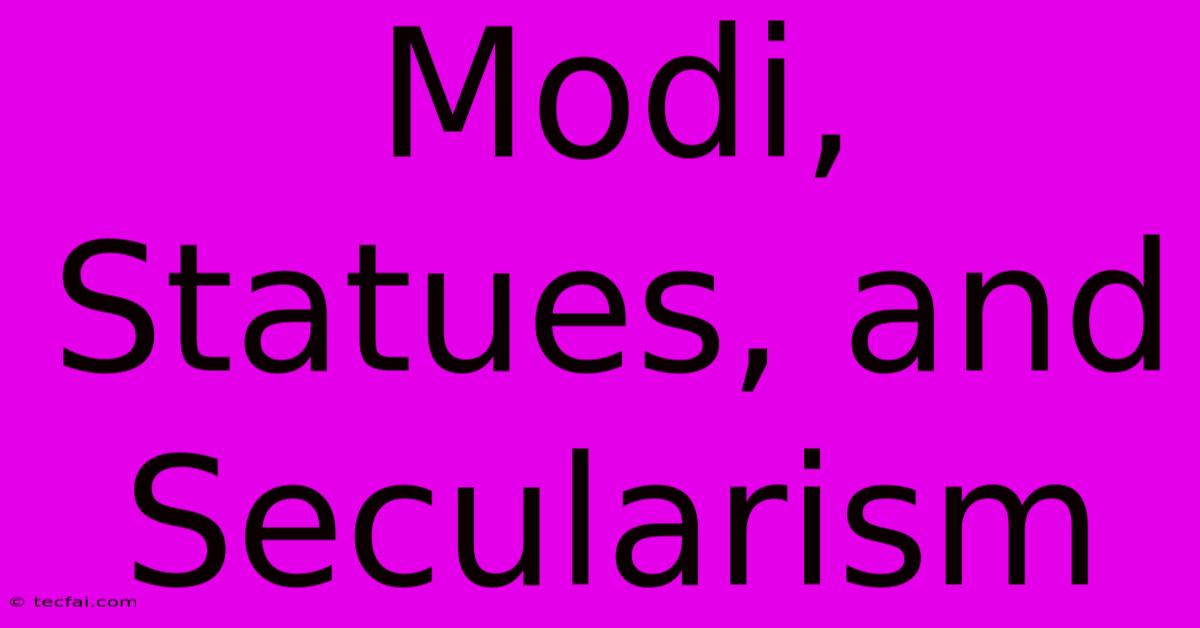Modi, Statues, And Secularism

Discover more detailed and exciting information on our website. Click the link below to start your adventure: Visit Best Website tecfai.com. Don't miss out!
Table of Contents
Modi, Statues, and Secularism: A Complex Interplay
The rise of large-scale statue projects during Narendra Modi's tenure as Prime Minister of India has sparked significant debate, particularly concerning their implications for India's secular ethos. While proponents cite economic benefits and cultural pride, critics argue these projects overshadow pressing social issues and potentially marginalize minority groups. This article delves into the complex interplay between Modi's administration, the proliferation of statues, and the ongoing conversation surrounding secularism in India.
The Statue Phenomenon: Scale and Significance
The construction of monumental statues, most notably the Statue of Unity, depicting Sardar Vallabhbhai Patel, is a defining characteristic of the Modi era. These projects are not merely artistic endeavors; they are significant state-sponsored initiatives involving substantial financial investment and considerable manpower. Beyond the Statue of Unity, numerous other statues of historical and contemporary figures have been erected across the country.
This scale raises several questions. Firstly, the economic cost of these projects is substantial, leading to debates about resource allocation and priorities. Are these funds being used effectively, or could they be better directed towards addressing critical social needs like poverty, healthcare, and education? Secondly, the selection of figures for memorialization is not without controversy. The choice often reflects a particular narrative of Indian history and national identity, potentially excluding or marginalizing certain voices and perspectives.
Secularism Under Scrutiny
The concept of secularism itself is multifaceted and subject to varied interpretations. In India, it's often understood as the principle of state neutrality towards religion. Critics argue that the emphasis on certain historical figures and the scale of these statue projects undermine this principle, promoting a particular vision of Indian nationalism potentially at odds with the country’s diverse religious landscape.
The religious composition of the figures chosen for monumental statues, and the associated narratives promoted, has also drawn criticism. While some argue that celebrating historical figures is inherently non-religious, others believe that the prominence given to certain religious identities implicitly endorses a specific worldview, potentially creating an environment of unease for religious minorities.
Countering Arguments and Perspectives
Supporters of these projects argue that they promote national pride, celebrating the achievements of prominent Indians and fostering a sense of collective identity. They also point to the economic benefits generated through tourism and associated industries. Furthermore, they contend that the construction of statues is a form of artistic expression and cultural preservation, regardless of religious affiliation.
However, critics argue that these justifications are insufficient. They highlight the potential for these projects to exacerbate existing social divisions and erode the principle of state neutrality, which is crucial for maintaining a secular society. The debate, therefore, extends beyond mere aesthetics and economic considerations; it touches upon the very core of India's national identity and the future of its secular fabric.
Moving Forward: A Balanced Approach?
The debate surrounding Modi, statues, and secularism demands a nuanced understanding of the complex issues at play. Finding a balanced approach that celebrates national heritage while upholding the principles of secularism and ensuring equitable resource allocation remains a crucial challenge. Open dialogue, critical analysis, and inclusive policy-making are essential to navigating this contentious terrain and fostering a truly inclusive and equitable society. The ongoing discussion is vital to ensuring a future where India’s diverse population feels represented and respected, regardless of religious or ideological affiliation.

Thank you for visiting our website wich cover about Modi, Statues, And Secularism. We hope the information provided has been useful to you. Feel free to contact us if you have any questions or need further assistance. See you next time and dont miss to bookmark.
Featured Posts
-
Actor Rupert Grints Tax Issue
Nov 30, 2024
-
Alexander Joins Lions Linebacker Bolstered
Nov 30, 2024
-
F1 Black Friday Best Deals
Nov 30, 2024
-
Swift Attends Chiefs Game With Kelce
Nov 30, 2024
-
Watch Boise State Vs Oregon State Football
Nov 30, 2024
